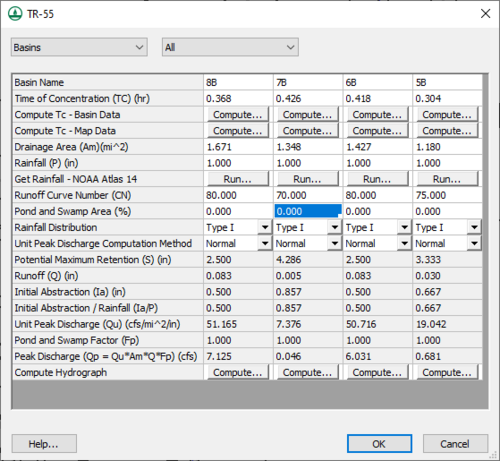WMS:TR-55 Edit Parameters: Difference between revisions
No edit summary |
|||
| (3 intermediate revisions by the same user not shown) | |||
| Line 5: | Line 5: | ||
==Name== | ==Name== | ||
The | The ''Basin Name'' is used to identify individual basins within a larger watershed. As with all basins created automatically in WMS, the name is defaulted to “ID”B where ID is an internal identification number and B stands for basin. The name can be changed to something more identifiable at any time. While TR-55 does not require that basin names are unique, other models supported by WMS do. | ||
==Channel Travel Time== | |||
{{TR55 Travel Times}} | |||
==Related Topics== | ==Related Topics== | ||
| Line 13: | Line 15: | ||
* [[WMS:TR-55 Basin Data#SCS (NRCS) Curve Number|Curve Number]] | * [[WMS:TR-55 Basin Data#SCS (NRCS) Curve Number|Curve Number]] | ||
* [[WMS:TR-55 Basin Data#Time of Concentration|Time of Concentration]] | * [[WMS:TR-55 Basin Data#Time of Concentration|Time of Concentration]] | ||
* [[WMS:TR-55 Basin Data#Rainfall|Rainfall]] | * [[WMS:TR-55 Basin Data#Rainfall|Rainfall]] | ||
* [[WMS:TR-55 Basin Data#Pond/Swamp Factor|Pond/Swamp Factor]] | * [[WMS:TR-55 Basin Data#Pond/Swamp Factor|Pond/Swamp Factor]] | ||
Latest revision as of 16:34, 19 December 2017
Once all of the input necessary to run a TR-55 simulation is defined, peak flow and hydrograph computations are made using the same dialog. The first time selecting the TR-55 data window, it lists the remaining information that must be entered before a peak flow is calculated. Once all of the items listed in this window are entered, WMS performs the calculation for peak discharge and displays the result in the same data window. Additional information (help) about any line selected in the TR-55 data window is displayed in the TR-55 help window.
The data window Display Options button allows controlling which information is displayed in the data window when the peak discharge is computed. The primary purpose for including the different display options is so that all results can be copied to the clipboard and then pasted into a report document.
Name
The Basin Name is used to identify individual basins within a larger watershed. As with all basins created automatically in WMS, the name is defaulted to “ID”B where ID is an internal identification number and B stands for basin. The name can be changed to something more identifiable at any time. While TR-55 does not require that basin names are unique, other models supported by WMS do.
Channel Travel Time
- The TR-55 travel time is the amount of time a flood wave takes to move from the outlet to the downstream most point of the watershed. This is different than other models in WMS which enter the travel time from outlet to outlet. Computed hydrographs at each basin and each outlet point represent the amount of the hydrograph at the outlet point contributed from each basin or each outlet point. Thus, the hydrographs are already lagged when running TR-55 in WMS. The upstream hydrographs are then simply added together to determine the hydrograph at the watershed outlet point. No lagging is done in WMS; tabulated TR-55 hydrographs are pre-lagged.
- Like time of concentration, travel times between outlets may be computed using a series of feature objects with equations such as Manning’s defined for each.
Related Topics
WMS – Watershed Modeling System | ||
|---|---|---|
| Modules: | Terrain Data • Drainage • Map • Hydrologic Modeling • River • GIS • 2D Grid • 2D Scatter |  |
| Models: | CE-QUAL-W2 • GSSHA • HEC-1 • HEC-HMS • HEC-RAS • HSPF • MODRAT • NSS • OC Hydrograph • OC Rational • Rational • River Tools • Storm Drain • SMPDBK • SWMM • TR-20 • TR-55 | |
| Toolbars: | Modules • Macros • Units • Digitize • Static Tools • Dynamic Tools • Drawing • Get Data Tools | |
| Aquaveo | ||
